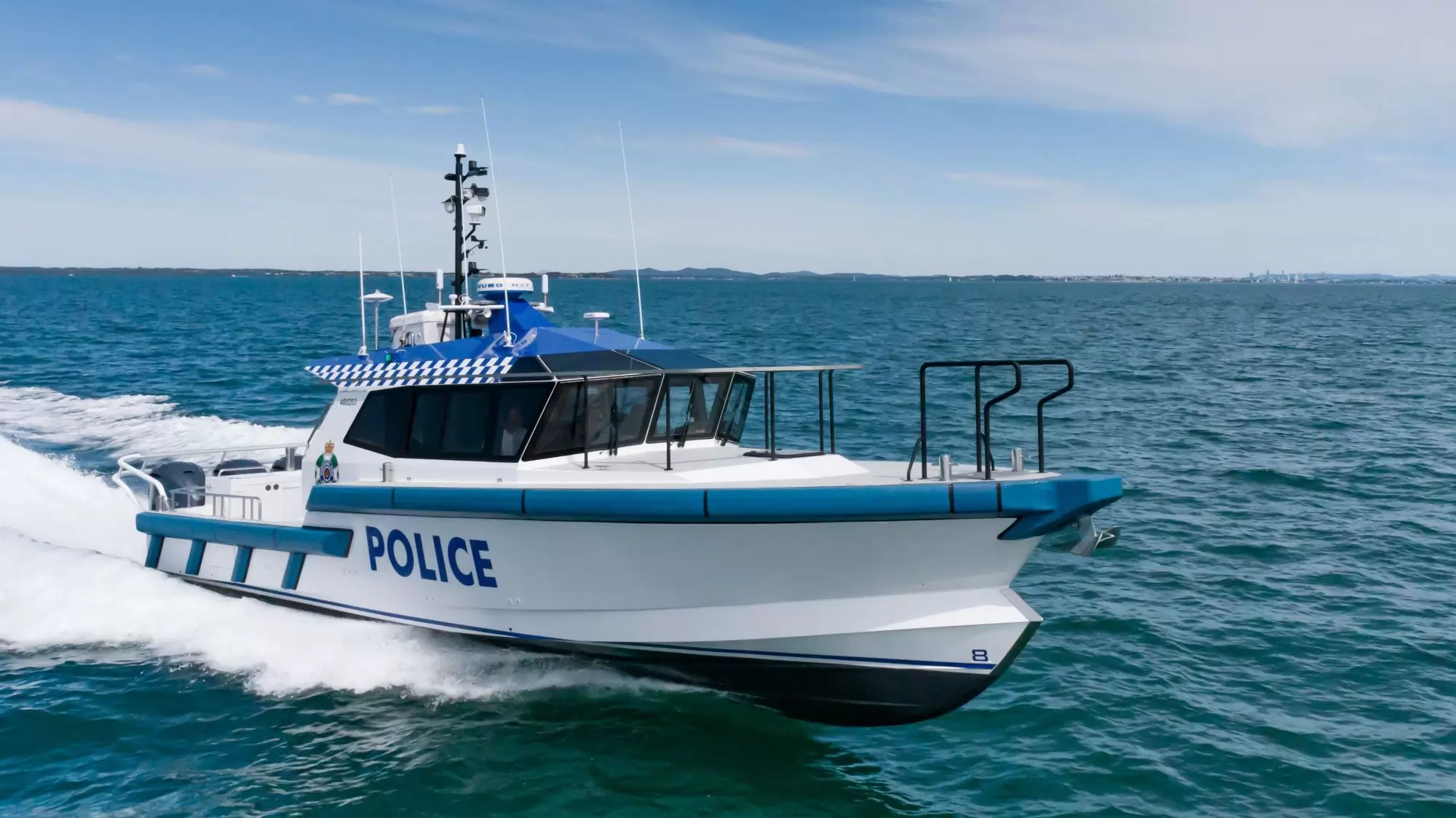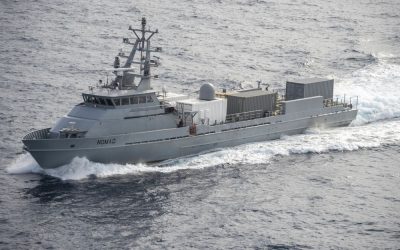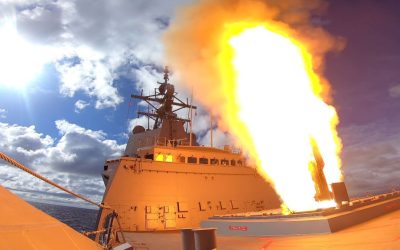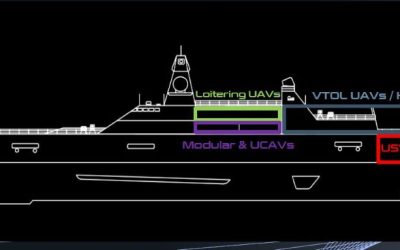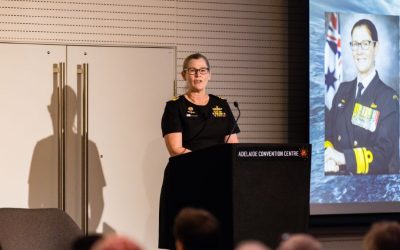Designed and built for “extreme use, without compromise”, the Queensland Police Service’s latest patrol boat delivery features a longer than usual waterline for a 12m craft
The Queensland Police Service (QPS) in north-east Australia is bolstering its waterborne activities with the first in a series of safe, seaworthy and highly customisable patrol vessels. Designed and built domestically by Norman R. Wright & Sons, the new 12m XLW patrol boat class has been developed to operate away from shore for extended periods, across a wide window of weather conditions and sea states, both in Queensland’s waters and in remote, offshore and tropical locations.
“This new class of vessel is designed from the ground up specifically for extreme patrol boat use, without compromise,” Adam Evripidou, director and head naval architect at Norman R. Wright & Sons, tells Ship & Boat International. Developed to be as configurable as possible, to suit the requirements of various police forces, search and rescue volunteers and border protection specialists, the 12m XLW hullform is based on that of the company’s existing 14.2m XLW pilot boat class.
Evripidou explains: “The 12m limit is driven by Australian Maritime Safety Authority [AMSA] requirements for the vessel’s crewing capabilities…an AMSA Grade 3 class coxswain can operate a vessel in National Standard for Commercial Vessels [NSCV] survey up to 12m in length.” Additionally, the debut 12m XLW’s structure has been approved by DNV for patrol boat applications. “The longer waterline has been proven by our larger 14m XLW class, and was also verified with computational fluid dynamics [CFD] before we signed off on the hull,” he continues. “The longer waterline offers a hull bottom that would normally be used to carry the deck of a 14m vessel, which allows this vessel to outperform other 12m patrol boats.”
Safe access
The first-in-class 12m XLW was built with an advanced composite structure: namely, a foam-cored epoxy glass sandwich. “Vessels built from aluminium with the same structural strength are anywhere from 1-2tonnes heavier,” says Evripidou. “The vessel is built using a proprietary construction method that lets us build within a timeframe comparable to that for aluminium-plate boats – and with equivalent costs – while structurally being relatively maintenance-free.” Removing the risk of aluminium corrosion should help the QPS to avoid inconvenient maintenance-/repair-related downtime.
The 12m XLW also borrows the design of its safety rail system from its pilot boat ‘big brother’, and this provides the crew with a full 360° travel around the vessel. “With the wide side decks and safety rail, we provide intercept zones high up forward, mid-height at midships and in a lower zone when in the cockpit when intercepting smaller vessels,” Evripidou says. The boat also features a fully automatic anchoring system, to assist with station-keeping, and a bow pusher fender, enabling it to push up to other vessels without causing them damage.
Personnel can board the 12m XLW over the bow, and the boat’s single swim ladder can be used at the side gate, and also off the foredeck, for speedy beach access.
Storage space
Evripidou highlights another key benefit of the 12m XLW’s cored-composite monocoque construction: a lack of internal hull stiffeners, combined with reduced framing. “All visible accommodation framing is structural, with uninterrupted storage behind these structural panels,” he says. “These storage lockers offer unimpeded hull inspections, as there is no flotation foam, which can hinder hull surveys, anywhere in the vessel.” All the same, and in order to meet AMSA’s ‘one compartment flooding’ standard, the 12m XLW incorporates inbuilt buoyancy chambers inside the boat’s transom pod.
The area beneath the cabin provides storage space for up to eight Pelican 1560 Protector hard cases, which would typically contain police equipment. Another space, located under the cockpit deck and accessible via aluminium watertight hatches, provides room for the storage of a swim ladder and ropes, as well as fire and salvage hoses.
Power and protection
The debutante 12m XLW is powered by three Yamaha F425 XTO outboards, delivering a cruise speed of 30knots at 161litres per hour, and top speeds in excess of 50knots at 421litres per hour. This is sufficient to grant the boat a range of 265nm at 30knots with 10% reserve. However, Evripidou says, the model could be tweaked to offer a range of up to 350nm, depending on how it is configured, and could alternatively incorporate a powertrain comprising twin outboards and Volvo IPS inboard diesel power.
The QPS boat is arranged for two crew (who have access to individual onboard berths) and eight special operatives. This craft also features a hard collar fender, for greater moulded beam and accommodation space, and for reduced maintenance, relative to inflatable fenders. A Westerbeke 6.2kVA generator is on hand to meet the vessel’s hotel power needs.
For the protection of both crew and personnel, particularly given the 12m XLW’s potential extreme speeds, the vessel features deck-mounted shock-mitigating seats, supplied by Shockwave, which come with deck slides, seat belts and lifting arm rests. “We also offer mechanical suspension seats on plinths, to provide additional storage,” Evripidou says.
Other moddable options include: full walkaround decks; the addition of an operator’s computer console in the cabin; a head in the accommodation; a full galley in the cabin; and an aft raked windscreen.
In addition to the QPS delivery, Norman R. Wright & Sons is currently working on further 12m XLW boats for various end users. Examples include a newbuild for Marine Parks, featuring twin Yamaha outboards for a speed of 40knots, and three units for the Australian Water Police, each of which will be powered by a pair of 283kW Volvo IPS models, and which will feature open transoms and tow posts.
TECHNICAL PARTICULARS
12m XLW Class Patrol Boat
Length 14.09m (oa), 12.44m (hull, incl. pod), 11.65m (hull, excl. pod)
Breadth: 4.06m (oa), 3.74m (moulded)
Draught: 1.04m (max), 0.62m (hull)
Air draught: 5.07m (incl. mast)
Displacement: 8,480kg (lightship), 10,600kg (fully laden)
Outboards: 3 x Yamaha F425 XTPO
Output of each outboard: 425hp (317kW)
Cruise speed: 30knots
Max speed: 50knots+
Petrol: 1,550litres
Fresh water 150litres
Sullage: 45litres
Crew: 2
Special personnel: 8
Classification society: DNV
Notations: DNV 1A HSLC R2 Patrol S, NSCV Class 2C
